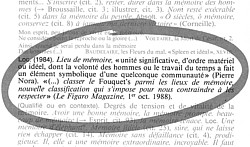|
Introduction
(back to top)
As part of a 2007 graduate seminar on "History in the Public Realm:
Collective Memory?" I thought it would be useful to collect the definitions
of various types of memory that scholars have come up with. Given the
wide range of meanings "collective memory" can have (for example
an object or a process), there are also a number of cognate terms.
I first offer in this box a bulleted list of the terms, then below,
in chronological order, quotations with exact citations.
- communicative vs. cultural memory (Jan Assmann 1988)
- collected memory (James Young)
- collective remembering (David Middleton and Derek Edwards 1990)
- collective remembrance (Winter and Sivan 1999, to emphasize social
agency)
- commemoration (John Gillis 1994, Sider & Smith 1997)
- countermemory (Foucault Language, Counter-Memory 1977; James
Young)
- dominant memory (Foucault)
- experiential memory
- generational memory
- heritage (Pierre Nora 1991: patrimoine)
- historical consciousness (Amos Funkenstein 1989; Jörn Rüsen:
Geschichtsbewusstsein)
- historical memory
- historical representations
- memory (John Gillis 1994, Andreas Huyssen 1995)
- national memory (Pierre Nora 1984)
- nostalgia (Michael Roth 1989, Charles Maier 1993, Peter Fritzsche
2002)
- official memory (Henri Rousso 1991, John Bodnar 1992)
- popular historymaking (Rosenzweig & Thelen 1998)
- postmemory (Marianne Hirsch 1997, Andrea Liss 1998)(2nd generation
memory)
- print memory ([Benedict Anderson])
- public memory (John Bodnar 1992, Harold Marcuse 2001)
- social memory (Connerton 1990; Fentress & Wickham, 1992)
- sociomental topography of the past (Eviatar Zerubavel, 2003: also mnemonic
traditions, battles)
- traditions (invented) (Eric Hobsbawm 1983)
- transactive memory (D.M. Wegner, 1988, in: Mullen & Goethals (eds.),
Theories of Group)
- vernacular memory (John Bodnar 1992)
These are distinguished from forms of individual memory/remembering:
- autobiographical memory
- flashbulb memory (Brown & Kulik, in Cognition vol. 5,
1977, pp. 73-99)
Additional terms denote the transmission of memories
- vectors of memory (Henri Rousso 1991; Nancy Wood 1999)
|
 Le Grand Robert definition of Lieu de memoire, from 1993 ed. (Nora v.3, 608)
Le Grand Robert definition of Lieu de memoire, from 1993 ed. (Nora v.3, 608)